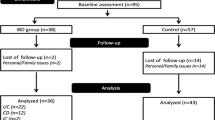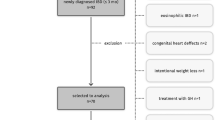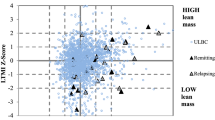Abstract
Objective: To assess body hydration and the distribution of the body water compartments in defined populations of patients with inflammatory bowel disease (IBD) compared with those of matched healthy controls.
Subjects: Fifty-two patients with IBD at time of diagnosis (20 patients with Crohn’s disease (CD-new) and 32 patients with ulcerative colitis (UC-new)), 40 patients with long-standing CD (CD-long) and 2 matched healthy control groups (n=52 and n=40) were recruited for the study.
Methods: Total body water (TBW) and extracellular water (ECW) were measured by deuterium oxide and bromide dilution, respectively. Intracellular water (ICW) was calculated as TBW-ECW. In addition, hydration of fat-free mass (FFM) and the ECW:ICW ratio were calculated. FFM, body fat (BF) and % body fat (%BF) were assessed by dual energy X-ray absorptiometry.
Results: In female IBD patients, the ECW:ICW ratio was significantly (P<0.05) higher than in controls (CD-new: 0.89±0.11 vs 0.79±0.08, P<0.01; UC-new: 0.85±0.15 vs 0.77±0.10, P<0.05; CD-long: 0.86±0.14 vs 0.80±0.10, P<0.05). In these female patients, the ICW:FFM ratio was significantly (P<0.05) lower than in controls. Fluid shifts were especially pronounced in female patients with recently diagnosed CD. In male patients with recently diagnosed UC and in those with long-standing CD, body weight, body mass index, BF and %BF were significantly (P<0.05) lower than in controls. No differences in body hydration or body water distribution were observed between male patients and controls.
Conclusions: An altered body water distribution and body hydration was observed in female IBD patients, especially in female patients with recently diagnosed CD.
Sponsorship: This study was financially supported by a grant from Novartis Nutrition Ltd, Switzerland.
This is a preview of subscription content, access via your institution
Access options
Subscribe to this journal
Receive 12 print issues and online access
$259.00 per year
only $21.58 per issue
Buy this article
- Purchase on Springer Link
- Instant access to full article PDF
Prices may be subject to local taxes which are calculated during checkout
Similar content being viewed by others
Author information
Authors and Affiliations
Rights and permissions
About this article
Cite this article
Geerling, B., van Marken Lichtenbelt, W., Stockbrügger, R. et al. Gender specific alterations of body composition in patients with inflammatory bowel disease compared with controls. Eur J Clin Nutr 53, 479–485 (1999). https://doi.org/10.1038/sj.ejcn.1600780
Received:
Revised:
Accepted:
Published:
Issue Date:
DOI: https://doi.org/10.1038/sj.ejcn.1600780
Keywords
This article is cited by
-
Sex Differences in Experimentally Induced Colitis in Mice: a Role for Estrogens
Inflammation (2015)
-
Body composition in patients with short bowel syndrome: An assessment by bioelectric impedance spectroscopy (BIS) and dual–energy absorptiometry (DXA)
European Journal of Clinical Nutrition (2004)
-
Body composition in patients with an ileostomy and inflammatory bowel disease: validation of bio-electric impedance spectroscopy (BIS)
European Journal of Clinical Nutrition (2002)



